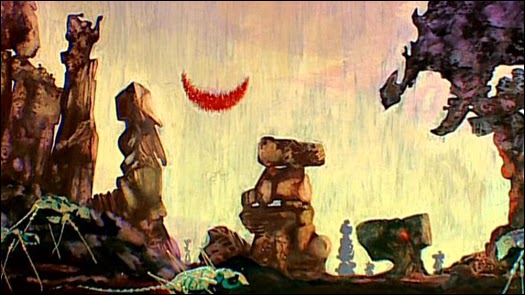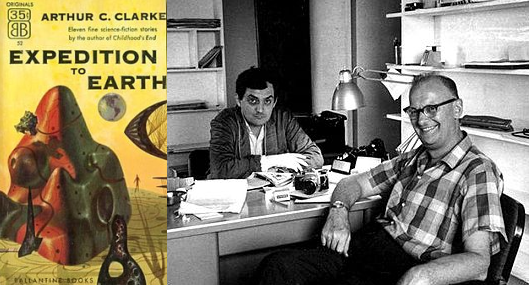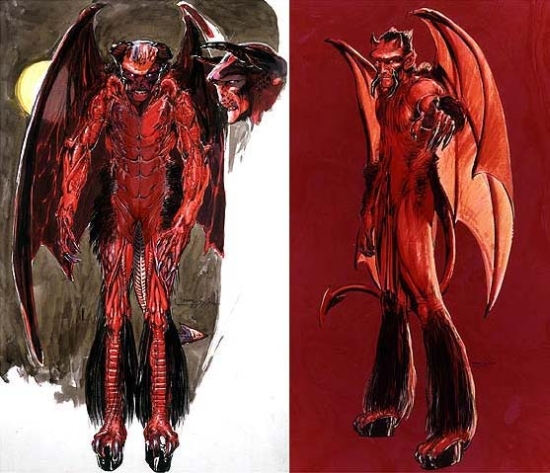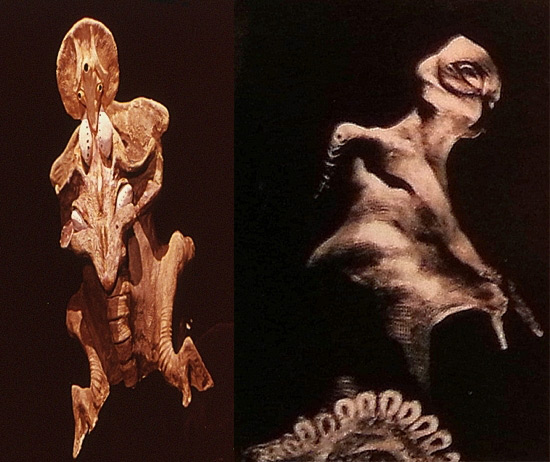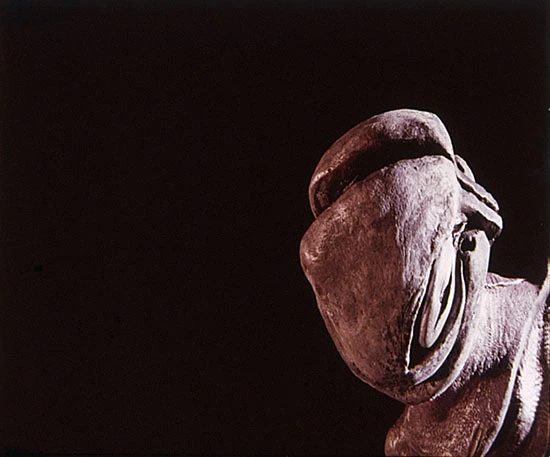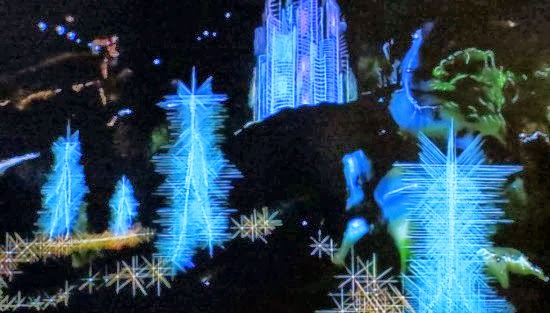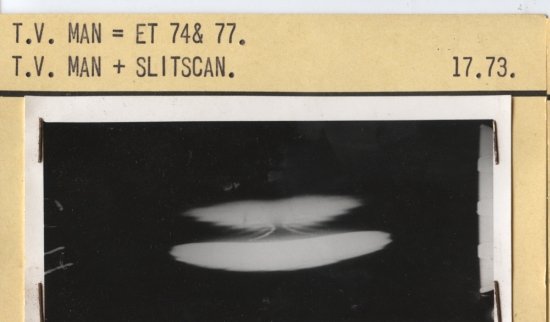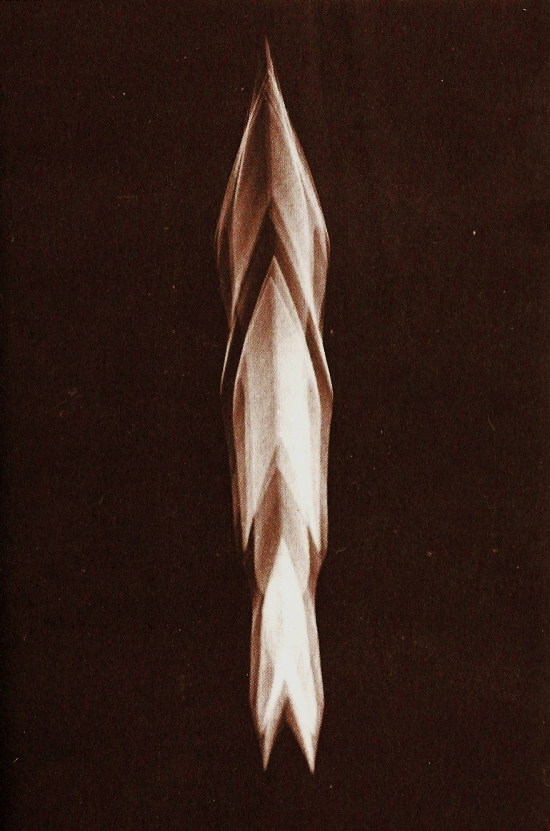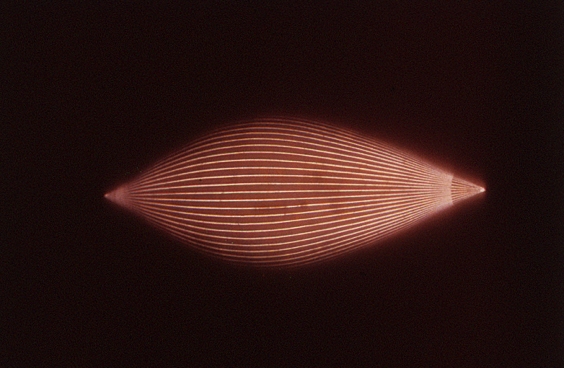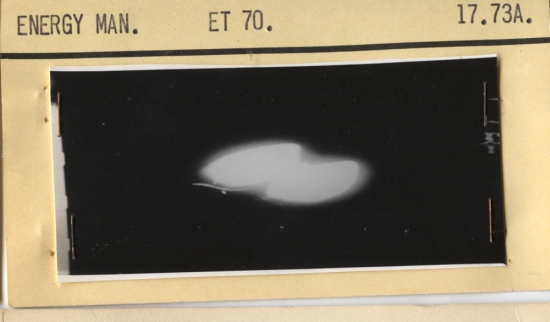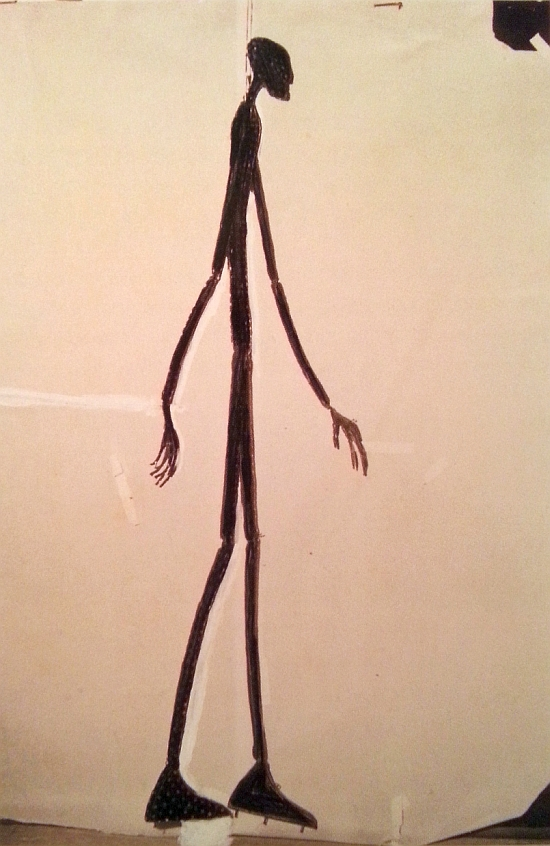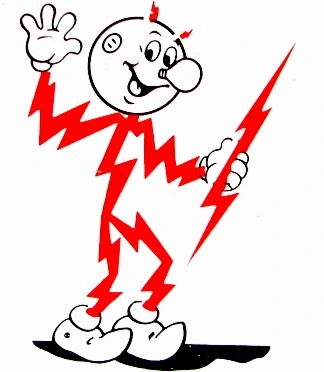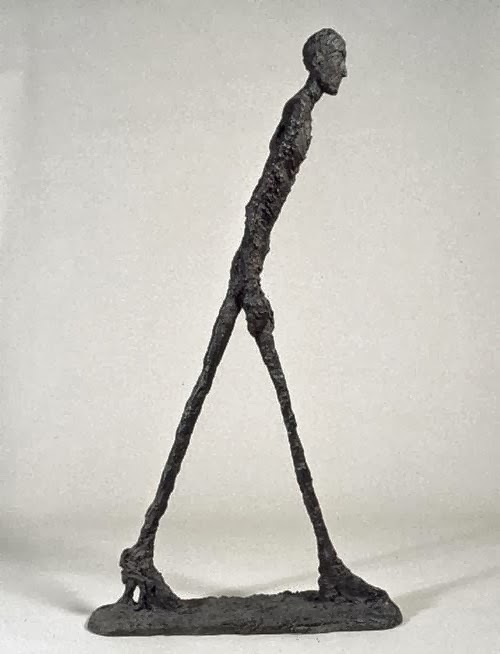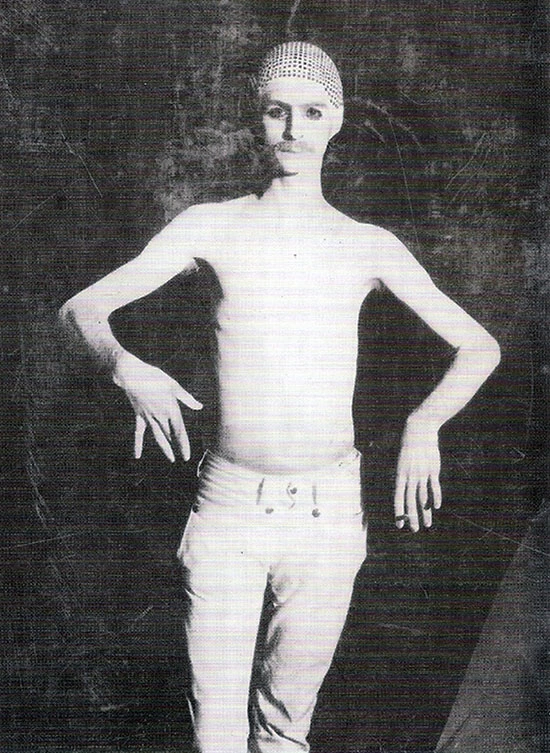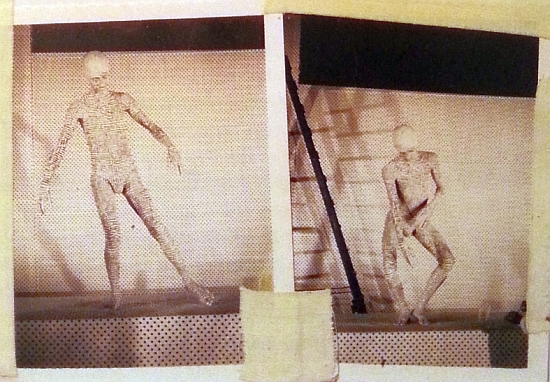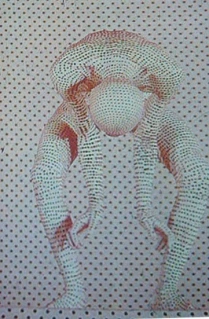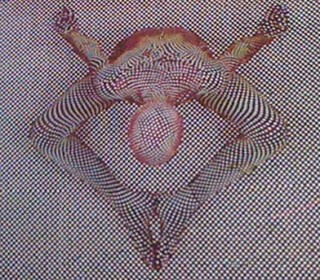1. Early conceptions
In a film like 2001, a project that started with the explicit purpose of investigating the possibility of extraterrestrial life, it comes as no surprise that Kubrick decided very soon in the production to tackle the problem of how to actually depict the extraterrestrials themselves.
Kubrick and Arthur C. Clarke had met for the first time in April 1964: by the last months of that year the director had already set up a team working on hundreds of drawings about possible E.T. shapes – his wife Christiane was on board as well and worked on preparatory drawings – and in late 1965, the young and recently hired collaborator Anthony Frewin joined the team, researching on modern sculptures, paintings of German artist Max Ernst and modern art in general to try different ideas. (Here’s a detailed account by Frewin about his appointment to the movie and about Kubrick fondness of Ernst; thirty years later, Ernst’s influence resurfaced in a Ian Watson interview about the making of the movie that turned out to be Spielberg’s Artificial Intelligence).
Some of those eerie alien landscapes are available, as ‘bonus materials’, in the DVD edition of2001 issued in 2007 (and captured in screenshots in these three fine websites); here’s an example of the material and a comparison with a famous painting from Ernst:
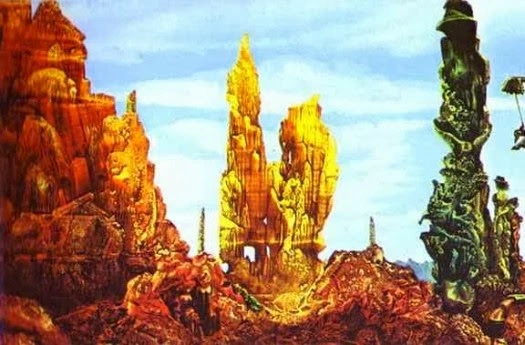
Another reason for an early start in the quest for a credible alien came from the script evolution. Arthur C. Clarke gives us an interesting hint about the many ideas pursued and abandoned; starting with an entry in his diary dated October 6, 1964, reproduced in the bookThe Lost Worlds of 2001:
Have got an idea which I think is crucial. The people we meet on the other star system are humans who were collected from Earth a hundred thousand years ago, and hence are virtually identical with us.
The earliest outline of the story drafted by Kubrick and Clarke featured the discovery of a extraterrestrial artifact not in the beginning of the story (as in The Sentinel, the 1948 novel that was chosen as a basis for the movie) but as the climax;
Before that, we would have a series of incidents or adventures devoted to the exploration of the Moon and Planets. […] The rest of 1964 was spent brainstorming. As we developed new ideas, so the original conception slowly changed. “The Sentinel” became the opening, not the finale.
So, now that the plot had to focus on an early meeting of alien and men that had to take place on earth, the script had to feature an explicit description of the alien. In a draft from 1965, the main alien character even had a name: Clindar; straightforwardly borrowed by Clarke from his old novel Encounter in the dawn (1954), originally collected in the anthologyExpedition to Earth.
Although not included in the series of novels whose rights Clarke had sold to Kubrick as a basis for the 2001, Encounter will end up giving the first part of the final movie its basic structure: Clindar is a very human-like alien who “could pass for an human with some surgery” and he’s basically an anthropologist that helps the struggling ape-men, showing them, among the other things, how to kill a hyena with a bone. Clearly, Clindar’s function is the same of what the monolith turned out to have in the finished movie: he’s a catalyst for the potential of the human race.
Slowly, Kubrick and Clarke decided to move the actual meeting of aliens and humans to the climax of the movie, in the final scene after the Stargate – basically trading places with the appearance of the alien artifact; and the monolith, that at this stage had already appeared on the moon as a pyramid as in The Sentinel, would take the place of the aliens as catalyst/teacher on the prehistoric earth.
2. from humanoids to gargoyles
Now Stanley wants to incorporate the Devil theme from Childhood’s End….
The resigned tone of the note is a telltale sign of the growing desperation of the writer to come up with themes that may satisfy the demanding Kubrick; but it’s also a reminder that the director was very interested in Clarke’s 1953 book Childhood’s End since the beginning of the project. Kubrick tried to buy the movie rights of the book but they were already under option by writer-director Abraham Pokonsky, and the same Metro-Goldwin-Mayer was in talks of producing a movie based on the book to be directed by George Pal. The project disappeared after MGM committed to 2001. (Clarke later told Kubrick that the director John Frankenheimer had been interested as well).
The book, one of Clarke’s best, had a large influence on 2001 and we will deal about it in a later blog entry. What is important right now is the fact that the revelation of the physical appearance of the aliens in the book is one of the most shocking in sci-fi history: they turn on to look like the traditional human folk images of demons – large bipeds with leathery wings, horns and tails. Maybe Kubrick was amused by this shocking revelation and the effect that it may have had on the audience?
A modern depiction of the Overlords in Childhood’s End (source)
This devilish theme is quickly dismissed in later script drafts, but some echoes are still recognizable in the following pictures of the alien sculptures produced for the movie:
They look very much like gargoyles, the grotesque statues seen on the walls of churches, cathedrals especially from the medieval age. According to Trumbull they were produced in rubber and it’s not known if they are models or prototypes for suits that actors had to wear. According to other sources, some of them were sculpted by Christiane Kubrick.
3. FX people have their say
The humanoid-alien concept was slowly morphing into something else in the subsequent scripts drafts, as the authors themselves were prone to experiment in different directions. In later drafts featured in The Lost Worlds of 2001, Clarke describes aliens with a typical “elongated” silhouette, similar in many ways to the sci-fi cliché that later movies will popularize, starting with Close Encounters of the third kind.
One of the members of the special effects crew of 2001, Wally Gentleman, recalls for Cinefex magazine that
In one treatment, the alien was to come along and take Bowman by the hand. It was going to be a towering insect-like creature – rather light and vaporous. One logical way to do this would have been to shoot the creature with a variable anamorphic lens to elongate the image onto film. With such a lens, you can squeeze the image from side to side and from top to bottom, and you can increase or decrease the ratio of the squeeze. Then, by projecting that squeezed image onto a mirror positioned in front of Bowman at an angle 45 degrees to the camera, we could have made the alien appeared to be standing right next to him, and it would all have been on the original negative. Quite traditional, really – the technique goes back to the stage arts.
Attempts were made to realize this concept, with an actor wearing a white suit; the results were judged “dull and unconvincing”.
Gentleman recalls also that
There were many other alien concepts – most of them created after I left. One was a cone-shaped thing with pea bulbs all over it – a tall mass of glittering light that looked like a Christmas tree. Kubrick had Doug Trumbull working on the thing, but Doug was rather contemptuous of the whole idea. Doug would always state just exactly what he was thinking – about everything – which I think nettled Stanley in the beginning, but he gradually got used to it. Doug was, after all, dealing from a position of authority since his work was so good, from concept to execution.
Now it’s Trumbull turn to speak.
We spent an enormous (in italics in the original text) amount of time trying to design extraterrestrials that we could include in the film. I produced quite a few alien effects using video feedback. Video feedback has a strange kind of lifelike quality to it, so I made a video feedback system for creating totally nonhumanoid shapes of pulsating light.
I also created some aliens using the same concepts as the City of Light (an effect conceived for the stargate sequence, later discarded), only rather than having a lot of little light bulbs, I put together a kaleidoscope projector that produced varying-diameter shapes, and then multiplied those into four facets and projected them onto a piece of white cardboard. As this thing moved in space, it would create a light image of variable volume that would be somewhat humanoid in shape. By changing the patterns in the kaleidoscope from a small diameter to a sudden larger diameter, I could roughly create the shape of a head, shoulders, arms, body and legs. Yet it was all just volumetric light that looked sort of like a jellyfish – transparent luminosity. There were things about it that worked and things about it that didn’t – such as, it was very difficult to get thee light characters to move or articulate. It just got to be terribly complex.
Brian Johnson, special effects assistant, was also involved in developing a number of alien concepts, which, like all of the others, would never reach fruition.
Stanley wanted something that was really different, but didn’t know just what. At one point he wanted something like a Giacometti sculpture – humanoid in shape, but very thin and distorted. So I got involved in producing a suit of light with about five thousand tiny bulbs wired onto it. The idea was to put one of the dancers we had choreographing the ape sequence into this suit – which was made out of black velvet – and the photograph him with star filters on the lens and various other things. The lights alone would define the creature.
Then we were going to squeeze the image in some way and distort it so that we’d have this weird creature that would float about. I worked on that for quite some time. We also went through a variation of that idea, utilizing a black velvet suit with a whole series of front-projection dots that we projected images onto. The thinking was that, without thousands of pea bulbs wired onto his suit, the dancer would have much greater flexibility of motion. But all this was near the end of production, and it never got cut in. I don’t think it was quite what Stanley wanted.
Antonio Giacometti’s famous sculpture “L’Homme qui marche I” (The walking man I) became in 2010 the most expensive sculpture ever sold in an auction: US$ 103,7 million, including the buyer’s premium. (source)
4. Last attempt: The Polka-dot man
Summer, 1967: the movie is almost finished, desperation is kicking in. Make-up maestroStuart Freeborn, recalls to Cinefex the experiments he supervised:
Stanley came up to me one day, and he said: “I’ve got an idea. What if we do a kind of optical illusion?” He had seen a dotted pattern somewhere, in front of a dotted-pattern background – and the result was something that was virtually invisible, yet somewhat visible just because it was on a different plane than the background. It was an intriguing idea, and Stanley asked me to begin working on something along those lines. So we got a performer, and I made a white bald cap that fit him nice and tight; then I put black round spots evenly all over it. I did the same thing on a pair of tights that covered the rest of his body. We got the largest paper hole-puncher we could locate, and stamped out perfect rounds of black paper, which we glued all over his white form. We covered him completely – right over his feet, all down his legs, everywhere.
Then we stood him against a white background with the same-size black dots all over it. The effect was stunning. Standing still, he would disappear into the backing; but when he moved, you could just make out a shape. It was an amazingly weird effect – quite extraordinary – but I don’t think it really fit in the movie. I could never see how Stanley was going to use it – and, of course, he never did.
“What do you want me to do, Stanley?”
“Well, Dan, we’ll start with you completely still, and when I give the word, move very slowly and sinuously”.
“Like this?” I hold my arms out to the side and move them in a wavelike manner as I slowly turn my head.
“That’s great, Dan. Do exactly that.”
I sit on the platform facing the camera with my legs in a relaxed lotus position and my arms out to each side. At the last moment, when Stanley is ready, I close my eyes and polka dots are applied to each eyelid.
“Action.” I hold very still.
“Okay, Dan, now you can move.”
I slowly undulate my arms and head as I turn from side to side. We try it a number of ways and that is that.
The next day at rushes, the footage comes up and, while extremely interesting, it is clear that you are looking at a person decked out in polka dots.
The effect doesn’t work. Stanley doesn’t mention it again.
5. Yes, but who got the idea, anyway?
According to Arthur Clarke, it was the famous scientist Carl Sagan that, asked for a suggestion on the topic, proposed to hide the aliens altogether from the movie, during a meeting at Kubrick’s house in Manhattan, in 1965. Quoted from Clarke’s biography, here’s Sagan recounting the episode thirty years later:
They had no idea how to end the movie – that’s when they called me in to try to resolve a dispute. The key issue was how to portray extraterrestrials that would surely be encountered at the end when they go through the Star Gate. Kubrick was arguing that the extraterrestrials would look like humans with some slight differences, maybe à la Mr. Spock (Ed. note: like Clindar). And Arthur was arguing, quite properly on general evolutionary grounds, that they would look nothing like us. So I tried to adjudicate as they asked.
I said it would be a disaster to portray the extraterrestrials. What ought to be done is to suggest them. I argued that the number of individually unlikely events in the evolutionary history of man was so great that nothing like us is ever likely to evolve anywhere else in the universe. I suggested that any explicit representation of an advanced extraterrestrial being was bound to have at least an element of falseness about it and that the best solution would be to suggest rather than explicitly to display the extraterrestrials.
What struck me most is that they were in production (some of the special effects, at least) and still had no idea how the movie would end.
Kubrick’s preference had one distinct advantage, an economic one: He could call up Central Casting and ask for twenty extraterrestrials. With a little makeup, he would have his problem solved. The alternative portrayal of extraterrestrials, whatever it was, was bound to be expensive.
… And that’s the quote from Arthur Clarke, commenting Sagan’s words:
A third of century later, I do not recall Stanley’s immediate reaction to this excellent advice, but after abortive efforts during the next couple of years to design convincing aliens, he accepted Carl’s solution.
It is to be said that another version of Clarke’s recount about the topic, in ‘Space Sage‘, (1997), goes more in-depth and suggests that Kubrick and Sagan didn’t go on very well together at all, a passage that Clarke omits in a reprint of “Space Sage” appeared in Clarke’sGreetings, Carbon-based bipeds (1999). Maybe he felt it was better to forget it, giving that Kubrick and Sagan had since, sadly, passed away.
Nevertheless, in the book Are we alone?, which reprints the interviews to various scientists on the topic of extraterrestrial life that Kubrick wanted to show in a short prologue to 2001 and were later discarded, Anthony Frewin (longtime Kubrick’s aide) felt in need to settle the score, stating that, regarding Sagan’s story (appeared also in his biography A life),
It’s a nice story, but it’s not true […] If Kubrick had followed Sagan’s suggestion we would not have done all this (Ed. note: he’s referring to his work and Christiane’s researches). At the end, Kubrick realized that showing aliens would not have been a good idea, just like it would not have been a good idea ending Dr. Strangelove with a pie fight.
(from the Italian version, re-translated in English)
6. Conclusion
In a 1970 interview, Kubrick said
From the very outset of work on the film we all discussed means of photographically depicting extraterrestrial creatures in a manner that would be as mind-boggling as the being itself. And it soon became apparent that you can not imagine the unimaginable. All you can do is try to represent it in an artistic manner that will convey something of its quality. That’s why we settled on the black monolith – which is, of course, in itself something of a Jungian archetype, and also a pretty fair example of “minimal art.”
The last part of the previous statement seems, in the face of the evidence exposed so far, more like an afterthought. Yes, Kubrick’s final choice was a stroke of genius, as witnessed by the unmatched symbolic status of the monolith in contemporary popular culture. But his research for a way to actually show the aliens on-screen continued in an almost uninterrupted fashion until a few weeks before the premiere of the movie – we could summarize the whole ordeal by saying that Kubrick tried to the last minute not to follow Sagan’s advice!
It seems now clear that the monolith, in its different shapes, and the actual presence of the aliens have co-existed for a long time in the development of 2001, the monolith is the only alien presence left in the movie rather than an alternative idea; in a way, the ‘survivor’ of the many different attempts made by K. and his crew and killed in the process.
Let’s leave the last world to Arthur Clarke and its imaginative prose:
Our ultimate solution now seems to me the only possible one, but before arriving at it we spent months imagining strange worlds and cities and creatures, in the hope of finding something that would produce the right shock of recognition. All this material was abandoned, but I would not say that any of it was unnecessary. It contained the alternatives that had to be eliminated, and therefore first had to be created. […] just as a sculptor, it is said, chips down through the stone toward the figure concealed within. (The Lost Worlds of 2001, p.189, 199)
By Simone Odino via 2001Italia
